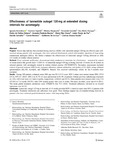Mostrar o rexistro simple do ítem
Effectiveness of lanreotide autogel 120 mg at extended dosing intervals for acromegaly
| dc.contributor.author | Bernabéu, Ignacio | |
| dc.contributor.author | Fajardo, Carmen | |
| dc.contributor.author | Marazuela, Mónica | |
| dc.contributor.author | Cordido, Fernando | |
| dc.contributor.author | Venegas, Eva | |
| dc.contributor.author | Pablos Velasco, Pedro de | |
| dc.contributor.author | Piedrola Maroto, Gonzalo | |
| dc.contributor.author | Olvera Márquez, María del Pilar | |
| dc.contributor.author | Pavón de Paz, Isabel | |
| dc.contributor.author | Carvalho, Davide | |
| dc.contributor.author | Romero, Carmen | |
| dc.contributor.author | De la Cruz, Guillermo | |
| dc.contributor.author | Álvarez Escolá, Cristina | |
| dc.date.accessioned | 2020-09-17T10:51:40Z | |
| dc.date.available | 2020-09-17T10:51:40Z | |
| dc.date.issued | 2020-07-28 | |
| dc.identifier.citation | Bernabéu I, Fajardo C, Marazuela M, et al. Effectiveness of lanreotide autogel 120 mg at extended dosing intervals for acromegaly. Endocrine. 2020. | es_ES |
| dc.identifier.issn | 1355-008X | |
| dc.identifier.uri | http://hdl.handle.net/2183/26205 | |
| dc.description.abstract | [Abstract] Purpose. Recent data indicate that extended dosing intervals (EDIs) with lanreotide autogel 120 mg are effective and well-received among patients with acromegaly who have achieved biochemical control with monthly injections of long-acting somatostatin analogues (SSAs). We further evaluated the effectiveness of lanreotide autogel 120 mg delivered at EDIs (>4 weeks) in routine clinical practice. Methods. Cross-sectional, multicentre, observational study conducted to determine the effectiveness—measured by control of serum insulin-like growth factor 1 (IGF-1)—of lanreotide autogel 120 mg at dosing intervals >4 weeks for ≥6 months in selected patients with acromegaly treated in routine clinical practice (NCT02807233). Secondary assessments included control of growth hormone (GH) levels, treatment adherence, patient satisfaction, and quality of life (QoL) using validated questionnaires (EQ-5D, AcroQoL, and TSQM-9). Patients who received radiotherapy within the last 6 months were excluded. Results. Among 109 patients evaluated, mean (SD) age was 59.1 (13.2) years. IGF-1 values were normal (mean [SD]: 175.0 [74.5], 95% CI: 160.8 –189.1) in 91.7% of cases and normal in 91.4% of patients without previous radiotherapy treatment (n = 81). GH levels were ≤2.5 and ≤1 ng/mL, respectively, in 80.6% and 58.3%. Most patients were treated either every 5–6 (57.8%) or 7–8 weeks (38.5%), with 2.8% treated greater than every 8 weeks. The mean AcroQoL score was 63.0 (20.1). The mean global treatment satisfaction score (TSQM-9) was 75.1 (16.6). Treatment adherence (defined as no missed injections) was 94.5%. Conclusion. Lanreotide autogel 120 mg at intervals of >4 weeks provided IGF-1 control in more than 90% of patients with acromegaly. Treatment satisfaction and adherence were good. These findings support use of extended dosing intervals in patients who have achieved good biochemical control with long-acting SSAs. | es_ES |
| dc.language.iso | eng | es_ES |
| dc.publisher | Springer | es_ES |
| dc.relation.uri | https://doi.org/10.1007/s12020-020-02424-z | es_ES |
| dc.rights | Atribución 4.0 España | es_ES |
| dc.rights.uri | http://creativecommons.org/licenses/by/4.0/es/ | * |
| dc.subject | Acromegaly | es_ES |
| dc.subject | Lanreotide | es_ES |
| dc.subject | Insulin-like growth factor 1 | es_ES |
| dc.subject | Somatostatin | es_ES |
| dc.subject | Growth hormone | es_ES |
| dc.title | Effectiveness of lanreotide autogel 120 mg at extended dosing intervals for acromegaly | es_ES |
| dc.type | info:eu-repo/semantics/article | es_ES |
| dc.rights.access | info:eu-repo/semantics/openAccess | es_ES |
| UDC.journalTitle | Endocrine | es_ES |
Ficheiros no ítem
Este ítem aparece na(s) seguinte(s) colección(s)
-
GI-FENM - Artigos [106]
-
INIBIC-EENM - Artigos [52]






